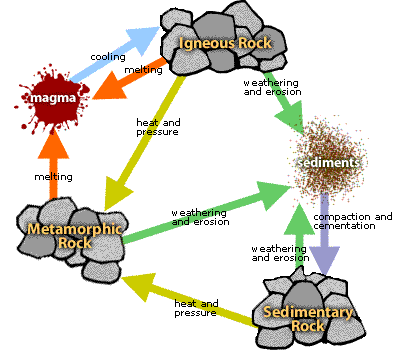The Rock Cycle
The materials of the Earth are constantly cycling through processes that change one sort of rock into another.
Rocks form in three main ways.
Igneous rocks form when molten magma cools and crystallises.
The most common igneous rocks are basalt and granite.

Basalt has small crystals because the magma has cooled quickly as a lava flow on the Earth's surface.
Granite has bigger crystals because it has cooled slowly underground.
But there are also chemical differences between types of igneous rocks.
Sedimentary rocks are made of material that has been broken up on the surface of the Earth, then gets deposited in layers.
Fossils of ancient animals and plants are often found in sedimentary rocks.
Some examples of sedimentary rocks are sandstone, shale and limestone.
All three can be seen in the Grand Canyon.

Metamorphic rocks are made when other rocks are heated, pressed or both.
Examples are slate, schist, phyllite and gneiss.

So the Rock Cycle connects all these processes.

Try this animated version of the Rock Cycle.
Rocks form in three main ways.
Igneous rocks form when molten magma cools and crystallises.
The most common igneous rocks are basalt and granite.

Basalt has small crystals because the magma has cooled quickly as a lava flow on the Earth's surface.
Granite has bigger crystals because it has cooled slowly underground.
But there are also chemical differences between types of igneous rocks.
Sedimentary rocks are made of material that has been broken up on the surface of the Earth, then gets deposited in layers.
Fossils of ancient animals and plants are often found in sedimentary rocks.
Some examples of sedimentary rocks are sandstone, shale and limestone.
All three can be seen in the Grand Canyon.

Metamorphic rocks are made when other rocks are heated, pressed or both.
Examples are slate, schist, phyllite and gneiss.

So the Rock Cycle connects all these processes.

Try this animated version of the Rock Cycle.